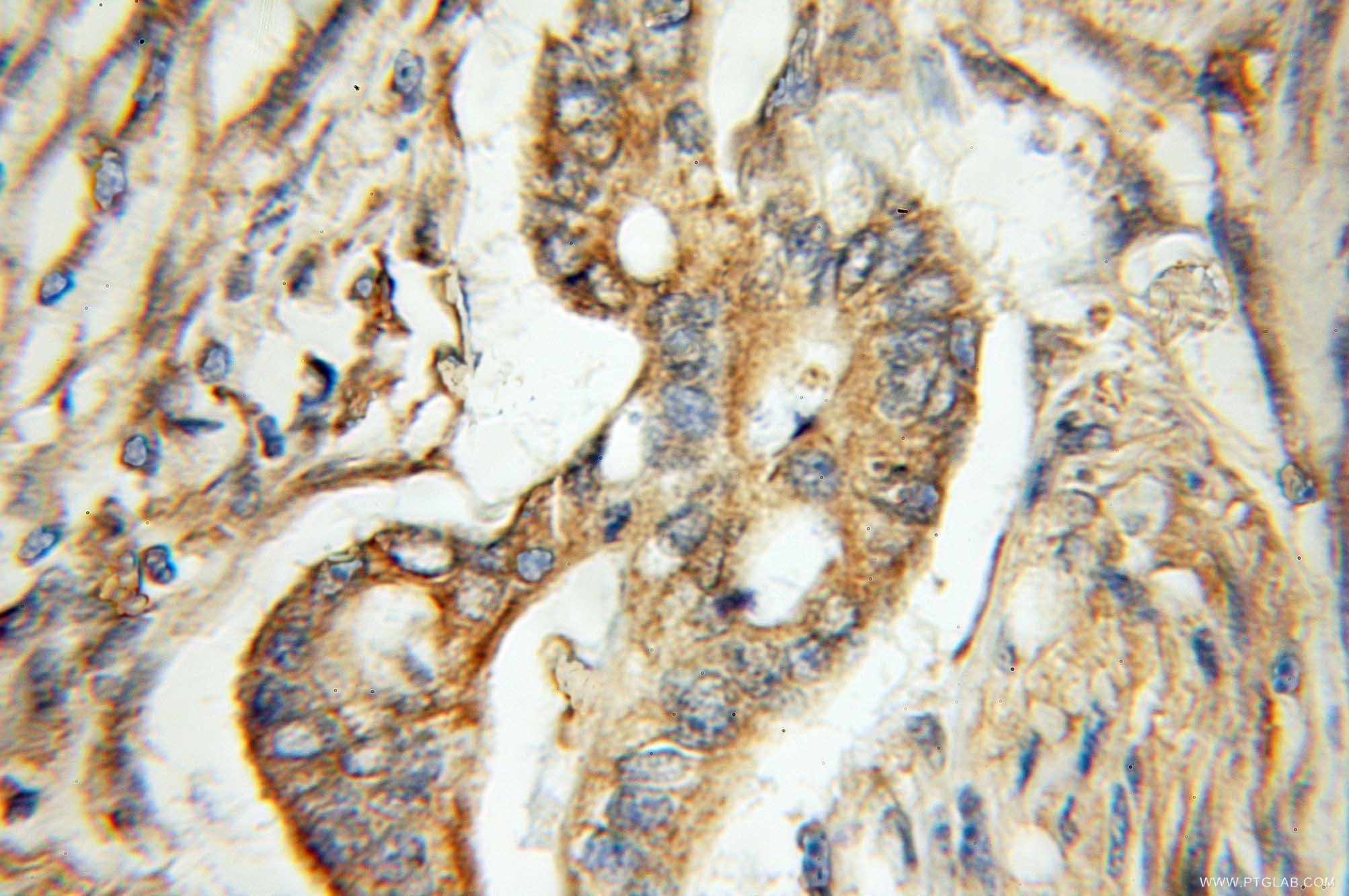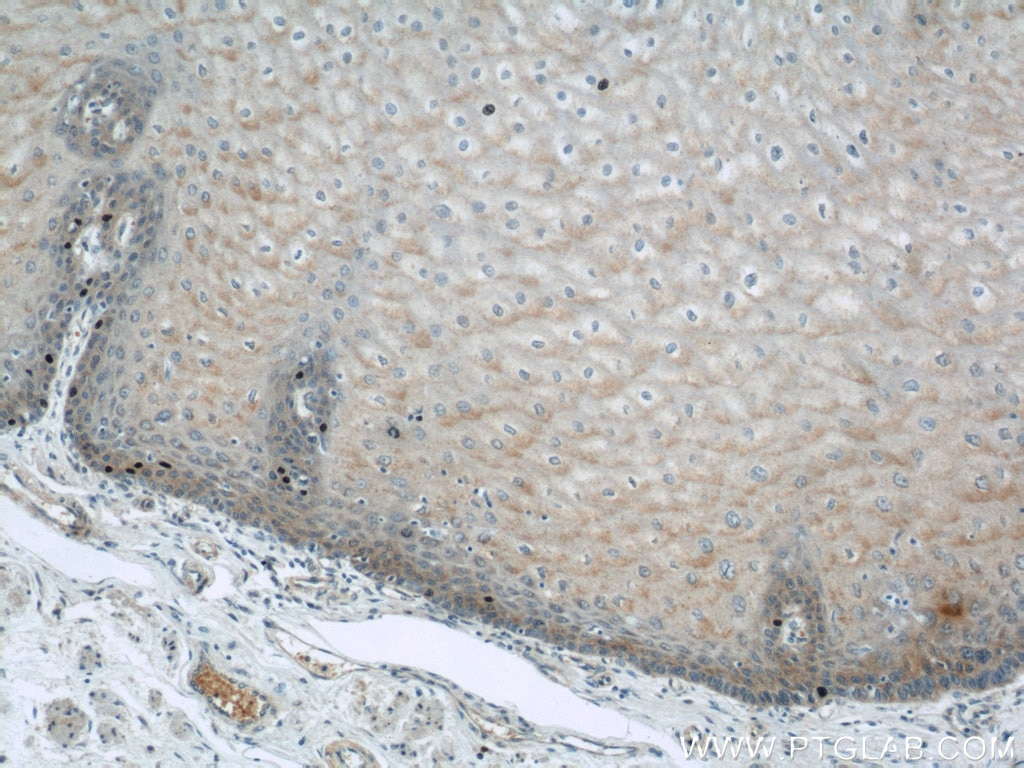- Phare
- Validé par KD/KO
Anticorps Polyclonal de lapin anti-ERO1LB
ERO1LB Polyclonal Antibody for WB, IF, IHC, ELISA
Hôte / Isotype
Lapin / IgG
Réactivité testée
Humain et plus (1)
Applications
WB, IHC, IF/ICC, ELISA
Conjugaison
Non conjugué
N° de cat : 11261-2-AP
Synonymes
Galerie de données de validation
Applications testées
| Résultats positifs en WB | cellules HeLa, tissu placentaire humain |
| Résultats positifs en IHC | tissu de cancer du pancréas humain, tissu d'intestin grêle humain, tissu œsophagien humain il est suggéré de démasquer l'antigène avec un tampon de TE buffer pH 9.0; (*) À défaut, 'le démasquage de l'antigène peut être 'effectué avec un tampon citrate pH 6,0. |
| Résultats positifs en IF/ICC | cellules HeLa |
Dilution recommandée
| Application | Dilution |
|---|---|
| Western Blot (WB) | WB : 1:500-1:2000 |
| Immunohistochimie (IHC) | IHC : 1:20-1:200 |
| Immunofluorescence (IF)/ICC | IF/ICC : 1:50-1:500 |
| It is recommended that this reagent should be titrated in each testing system to obtain optimal results. | |
| Sample-dependent, check data in validation data gallery | |
Applications publiées
| KD/KO | See 3 publications below |
| WB | See 6 publications below |
Informations sur le produit
11261-2-AP cible ERO1LB dans les applications de WB, IHC, IF/ICC, ELISA et montre une réactivité avec des échantillons Humain
| Réactivité | Humain |
| Réactivité citée | Humain, souris |
| Hôte / Isotype | Lapin / IgG |
| Clonalité | Polyclonal |
| Type | Anticorps |
| Immunogène | ERO1LB Protéine recombinante Ag1776 |
| Nom complet | ERO1-like beta (S. cerevisiae) |
| Masse moléculaire calculée | 54 kDa |
| Poids moléculaire observé | 40~50 kDa |
| Numéro d’acquisition GenBank | BC032823 |
| Symbole du gène | ERO1LB |
| Identification du gène (NCBI) | 56605 |
| Conjugaison | Non conjugué |
| Forme | Liquide |
| Méthode de purification | Purification par affinité contre l'antigène |
| Tampon de stockage | PBS avec azoture de sodium à 0,02 % et glycérol à 50 % pH 7,3 |
| Conditions de stockage | Stocker à -20°C. Stable pendant un an après l'expédition. L'aliquotage n'est pas nécessaire pour le stockage à -20oC Les 20ul contiennent 0,1% de BSA. |
Informations générales
Endoplasmic reticulum oxidoreductases (Eros) are essential for the formation of disulfide bonds. Mammals express two related Ero proteins, Ero1L alpha and Ero1L beta. The two homologous proteins can form homodimers and mixed heterodimers. ERO1-Lα and -β are highly expressed in organs with a high demand for secretion, consistent with their roles in oxidative folding of ER proteins.
Protocole
| Product Specific Protocols | |
|---|---|
| WB protocol for ERO1LB antibody 11261-2-AP | Download protocol |
| IHC protocol for ERO1LB antibody 11261-2-AP | Download protocol |
| IF protocol for ERO1LB antibody 11261-2-AP | Download protocol |
| Standard Protocols | |
|---|---|
| Click here to view our Standard Protocols |
Publications
| Species | Application | Title |
|---|---|---|
Hum Mol Genet Curcumin Facilitates a Transitory Cellular Stress Response in Trembler-J Mice. | ||
J Biol Chem Action of protein disulfide isomerase on proinsulin exit from endoplasmic reticulum of pancreatic β-cells. | ||
Sci Rep Hypoxia-inducible ERO1α promotes cancer progression through modulation of integrin-β1 modification and signalling in HCT116 colorectal cancer cells.
| ||
J Toxicol Oxidative Stress and the ER Stress Response in a Murine Model for Early-Stage Alcoholic Liver Disease. | ||
ACS Bio Med Chem Au Identification of Natural Product Sulfuretin Derivatives as Inhibitors for the Endoplasmic Reticulum Redox Protein ERO1α
|










